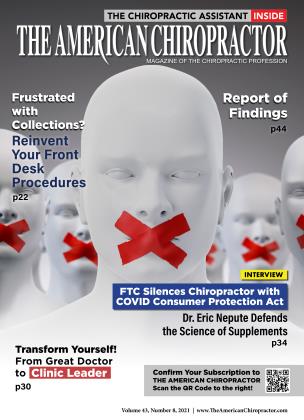Documentation is the only way clinicians have to report services to patients, families, physicians, audit committee reviewers, and claims reviewers. Documentation demonstrates your expertise and should provide clinical direction and accountability during the treatment process from the initial evaluation to patient discharge. The following dos and don’ts are designed to present strategies to enhance the value of the documentation process.
1. Don’t approach your documentation as a necessary evil. Do consider the value that good documentation brings to the clinical experience for you, for the patient, for the patient’s family, and for the payer. This goes beyond the well-known adage, ‘if it isn’t documented, it wasn’t done.’ Documentation can actually serve as a clinical partner to help direct the therapeutic process through continuous analysis of treatment activities, progress comparisons, and adjustments made to accommodate patient clinical changes. Well-documented chart notes tell the story of the patient’s overall care and treatment responsiveness.
2. Don’t use daily snapshots of clinical activity. Traditional reporting styles use snapshots depicting treatment results at isolated intervals during the therapeutic process. A lack of linkage between these reporting events may detract from the continuity and accountability of service delivery. Do use a continuous care plan improvement approach to benchmark progress over time and connect that progress in writing for the readers. Words should reflect what has happened, what is happening, and what will happen in the future. Be very specific and adopt consistent language to minimize reader confusion and simplify your efforts. Documenting the short and long-term goals supports the medical necessity of clinical decisions. When using a continuous care plan improvement approach for treatment activities focused on improving a clinical skill, documentation might look like the following example:(Name) improved his/her ability to stand and walk short distances from less than 15 minutes at a time to approximately 60 minutes at a time. This resulted in her ability to independently complete activities of daily living (ADL) such as preparing meals and cleaning her kitchen. Upcoming treatment will focus on lengthening the amount of time she can stand without pain and being able to take her dog for short walks.
3. Don’t keep moving the clinical signpost. Do use systematic progress benchmarks over time provide a mechanism for comparing, analyzing, and adjusting treatment effectiveness. Begin this process by establishing initial benchmarks in each of the patient’s deficit areas at the time of the evaluation. Repeat and compare benchmarks at designated intervals during the treatment process. The key to managing benchmarks is to:
4. Don’t ignore why the patient has come to seek clinical services. Do develop a functional outcome goal(s). Outcome goals are functional, not necessarily measurable goals, and reflect an understanding of the patient’s functional profile areas, realistic outcome expectations, and the motivations of the patient. Outcome goals do not replace the long-term and short-term goal requirements. The patient may be able to provide his/her own outcome goal. For example, a patient might say at the termination of treatment, they would like to be able to walk for 1 mile without lower back pain.
5. Don’t think of documentation as a standalone event. Do recognize that documentation is integrally tied with coding and billing and has your signature on it making it a legal document and making you legally responsible. The hierarchy of the administrative responsibility for the care process lies at the heart of audit reviews and service payments are rooted in documentation. Each chart note serves three distinct purposes. It is a communication tool between clinicians, it is your defense in a risk management situation, and it supports the reimbursement received. The claims review and audit process works like this:
The importance of consistent, complete documentation in the medical record cannot be overemphasized. Without such documentation, accurate coding cannot be achieved. The entire record should be reviewed to determine the specific reason for the encounter and the conditions treated.
6. Don’t ignore the obvious professional standards. Do demonstrate professionalism with each piece of documentation. An electronic health record (EHR) may reduce the time spent charting but it doesn’t reduce the time needed to proof for basic grammar and spelling. Laterality, levels treated, even the consistency throughout the note of the pronouns used to identify the patient all contribute to the completeness of the note. Adding a disclaimer that a voice recognition software was utilized doesn’t excuse the lack of effort to proof the note. Just do it.
Documentation is the vehicle clinicians have that explains services to patients, families, physicians, audit committee reviewers, and claims reviewers. It is the only tool you have to demonstrate your expertise and professionalism. Documentation provides clinical direction and accountability during the treatment process, and coordinates the clinical process with coding and billing. Good documentation is a truly valuable treatment partner.
Do:
• Make documentation a clinical partner
• Use a continuous care plan improvement logic approach
• Use systematically designed progress benchmarks
• Develop outcome goal(s)
• Tie documentation with coding and billing
• Demonstrate your professionalism
Karna Morrow, CPC, RCC, CCS-P, is the client services manager for Practice EHR. She has spent nearly three decades in the industry leading electronic health record (EHR) implementations and providing consulting and training for a variety of healthcare organizations. Morrow is a frequent contributor to highly regarded industry publications and national conferences, providing insights on practice management, coding, billing, and other industry-related topics. For more information about Practice EHR, visit www.practiceehr.com, email [email protected], or call 469-305-7171.
References:
1. Icdl0cm_guidelines_2014.pdf page 1
2. Bebb, G. Pro Write Caseload Management and Documentation System, Copyright 2006
 View Full Issue
View Full Issue









